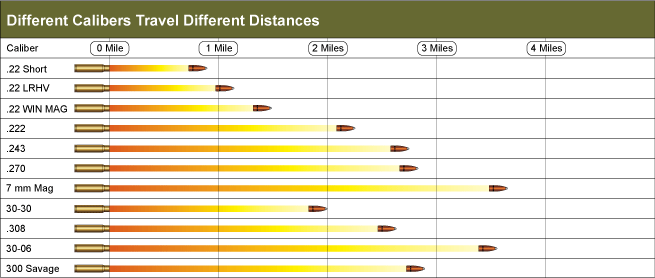Yes, a .243 bullet can travel thousands of yards. However, maximum distance isn’t the only thing to consider. This comprehensive guide breaks down everything you need to know about the .243 Winchester bullet range, from its effective range for hunting to its extreme potential.

Image Source: images.ctfassets.net
The .243 Winchester: A Versatile Cartridge
The .243 Winchester is a popular centerfire rifle cartridge known for its flat trajectory, moderate recoil, and effectiveness on a variety of game animals. It’s a favorite among varmint hunters, deer hunters, and target shooters alike. Its versatility stems from the fact that it uses a relatively small bullet with a high velocity, making it accurate and effective at various distances. We will delve into what affects the actual range of the bullet.
Unpacking .243 Ballistics
.243 ballistics are influenced by several factors, including bullet weight, bullet shape (ballistic coefficient), powder charge, and environmental conditions. The ballistic coefficient (BC) is a measure of how well a bullet overcomes air resistance. A higher BC means the bullet will retain more of its velocity downrange and be less affected by wind.
- Bullet Weight: .243 bullets typically range from 55 grains to 100 grains. Lighter bullets generally have higher velocities but may be more susceptible to wind drift. Heavier bullets retain energy better at longer ranges.
- Bullet Shape (Ballistic Coefficient): Streamlined bullets with pointed tips have higher BCs than round-nosed bullets.
- Powder Charge: A larger powder charge will result in a higher muzzle velocity, affecting the entire trajectory.
- Environmental Conditions: Air density, temperature, wind speed, and direction all play a role in .243 bullet trajectory.
Decoding .243 Bullet Trajectory
.243 bullet trajectory is the path the bullet takes from the rifle’s muzzle to the target. Due to gravity, the bullet begins to drop as soon as it leaves the barrel. This drop is counteracted by aiming the rifle slightly upwards. The point where the bullet’s trajectory intersects the line of sight is called the “zero range.”
What is Zero Range? Zero range is the distance at which your bullet will hit exactly where you’re aiming. Most hunters zero their .243 rifles at 100 or 200 yards.
The Importance of .243 Bullet Speed
.243 bullet speed is crucial for both accuracy and terminal performance (how effectively the bullet expands or fragments upon impact). Higher velocity generally translates to a flatter trajectory, making it easier to hit targets at longer ranges. A typical 100-grain .243 bullet has a muzzle velocity around 2960 feet per second (fps). The bullet will slow down over distance. A bullet’s velocity affects how much energy it carries.
.243 Winchester Bullet Range
The overall range of a bullet, or how far it can travel, is much further than what a hunter should use for ethically killing game. The following sections will help you understand ethical hunting distance and the maximum range.
.243 Effective Range: Ethical Hunting Distance
The .243 effective range for hunting is the distance at which the cartridge can reliably deliver a lethal shot. This depends on several factors, including:
- Game Animal: Larger game animals require more energy for a clean kill.
- Bullet Selection: Hunting bullets are designed to expand or fragment upon impact, transferring energy to the target.
- Shot Placement: A well-placed shot to the vital organs is essential.
- Shooter Skill: Accuracy is paramount.
For deer-sized game, a good rule of thumb is to limit your shots to 300 yards or less. For smaller game like coyotes, the effective range can extend to 400 yards, assuming the shooter is skilled and confident in their abilities.
What is the .243 effective range for deer hunting? The .243 effective range for deer hunting is generally considered to be around 300 yards or less for ethical and humane kills.
.243 Maximum Range: The Extreme Limit
The .243 maximum range is the distance the bullet can travel before it loses all its energy and falls to the ground. This distance is significantly further than the effective range. Under ideal conditions, a .243 bullet can travel well over 4,000 yards (approximately 2.5 miles). However, at such distances, the bullet’s trajectory is highly unpredictable, and it poses a significant safety hazard. Shooting at these distances is generally reserved for target shooting in controlled conditions.
Warning: Shooting at maximum range can be dangerous. Always be aware of your surroundings and ensure a safe backstop.
Grasping .243 Bullet Drop
.243 bullet drop is the amount the bullet falls below the line of sight at a given distance. Bullet drop increases dramatically as the distance increases. For example, a .243 bullet zeroed at 200 yards might drop 6-8 inches at 300 yards, and 24-30 inches at 400 yards.
- Bullet Drop Charts: These charts provide detailed information on bullet drop at various distances.
- Ballistic Calculators: These tools allow you to input specific bullet data and environmental conditions to calculate bullet drop.
Is .243 Long Range Shooting Possible?
Yes, .243 long range shooting is possible, but it requires specialized equipment, training, and a thorough understanding of ballistics. Long-range shooters often use high-BC bullets, adjustable scopes, and rangefinders to compensate for bullet drop and wind drift. However, the .243 is not generally considered an ideal long-range cartridge due to its relatively light bullet weight and susceptibility to wind.
Can I use a .243 for long range shooting? While it’s possible to use a .243 for long range shooting, it’s not generally considered ideal due to its lighter bullets and greater susceptibility to wind compared to larger, heavier cartridges.
Factors Influencing .243 Bullet Travel
Several factors influence how far a .243 bullet will travel and where it will impact.
Wind Drift
Wind drift is the horizontal displacement of the bullet due to wind. Wind drift is affected by wind speed, wind direction, bullet BC, and distance to the target. A 10 mph crosswind can cause a .243 bullet to drift several inches at 300 yards.
Altitude and Temperature
Altitude and temperature affect air density, which in turn affects bullet trajectory. Higher altitudes and warmer temperatures result in lower air density, which can reduce bullet drag and increase range.
Rifle and Scope Setup
A properly zeroed rifle and a high-quality scope are essential for accurate shooting. Adjustable scopes allow you to compensate for bullet drop and wind drift.
.243 Winchester: Loads and Their Performance
The .243 Winchester offers a range of bullet weights and types to suit different shooting applications. Here are some common .243 loads and their typical performance:
| Bullet Weight (grains) | Muzzle Velocity (fps) | Ballistic Coefficient (BC) | Typical Use |
|---|---|---|---|
| 55 | 3900 | 0.270 | Varmint Hunting |
| 80 | 3300 | 0.330 | Varmint/Small Game |
| 95 | 3100 | 0.400 | Deer/Antelope |
| 100 | 2960 | 0.420 | Deer/Antelope/Target |
These values are approximate and can vary depending on the specific ammunition and rifle.
Selecting the Right .243 Load for Your Needs
Choosing the right .243 load depends on the type of shooting you’ll be doing.
- Varmint Hunting: Lighter, faster bullets (55-80 grains) are ideal for varmint hunting. They offer flat trajectories and explosive expansion on small targets.
- Deer Hunting: Heavier bullets (95-100 grains) are recommended for deer hunting. They provide adequate penetration and energy transfer for a clean kill.
- Target Shooting: Match-grade bullets with high BCs are preferred for target shooting. They offer consistent accuracy and reduced wind drift.
Safe Shooting Practices
Regardless of the cartridge you are using, it is important to follow safe gun practices at all times.
- Always treat every firearm as if it is loaded.
- Never point the muzzle at anything you don’t intend to shoot.
- Be sure of your target and what is beyond it.
- Wear appropriate eye and ear protection.
- Store firearms and ammunition securely.
Responsible Hunting
When hunting, it is essential to practice ethical and responsible hunting.
- Know your limitations and don’t take shots beyond your effective range.
- Be sure of a clean and lethal shot before pulling the trigger.
- Respect the game and the environment.
- Follow all hunting regulations.
FAQ: .243 Winchester
Here are some frequently asked questions about the .243 Winchester.
What is the .243 Winchester good for? The .243 Winchester is a versatile cartridge suitable for varmint hunting, deer hunting, and target shooting. Its flat trajectory and moderate recoil make it a popular choice for a variety of applications.
Who is the .243 Winchester good for? The .243 Winchester is a good choice for youth hunters, women, and anyone who prefers a cartridge with moderate recoil. It’s also a good option for hunters who pursue a variety of game animals.
Can a .243 kill a bear? While a .243 can kill a bear with perfect shot placement, it’s not recommended as a primary bear hunting cartridge. Larger, more powerful cartridges are better suited for the task.
How much does a .243 bullet drop at 500 yards? The bullet drop for a .243 at 500 yards can vary significantly depending on the bullet weight, BC, and muzzle velocity. However, a typical 100-grain bullet might drop 60-80 inches at 500 yards.
What is the best zero range for a .243? The best zero range for a .243 depends on the intended use. For deer hunting, a 200-yard zero is a good compromise between trajectory and point-blank range. For varmint hunting, a 100-yard zero might be preferred for flatter trajectory at shorter distances.
Conclusion
The .243 Winchester is a capable and versatile cartridge. Its flat trajectory, manageable recoil, and effectiveness on a variety of game animals make it a popular choice for hunters and target shooters alike. While the .243 maximum range is extensive, responsible shooters prioritize accuracy and ethical hunting practices by limiting their shots to within the effective range. By understanding the factors that influence .243 ballistics, you can make informed decisions about bullet selection, zero range, and shooting technique, ensuring safe and successful shooting experiences.

Hi, I’m Candace Wafford, a travel and food blogger based in Lexington, Kentucky. As a corporate traveler, I’ve had the chance to explore a lot of places, but now I’m on a mission to travel full-time. My goal? To figure out how to take my cat along for the adventure! Here at destinationdorworth.com, I share my experiences and tips on outdoor activities, travel, and of course, the best food spots I come across. I hope my blog inspires you to explore more and eat well on your journeys!
